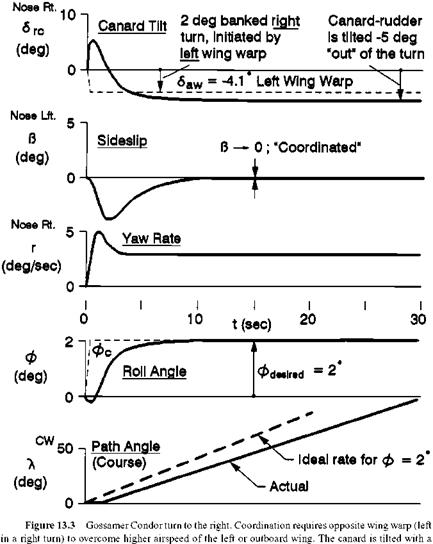Turning Human-Powered Ultralight Airplanes
Roll and yaw control have emerged as major problems for human-powered ultralight airplanes. This appeared in the competition for the first Kremer Prize. Winning the prize required that a figure-eight maneuver be performed around pylons one-half mile apart. Henry R. Jex (1979) says:
Early analyses [of the Gossamer Condor]… revealed the futility of conventional aileron control for roll, the need for some fin area to enhance Cye and Cne; and the seeming paradox that twisting the wing for a leftward rolling moment would quickly produce a yawing velocity and roll angle to the right! … Warping the wings for a left-wing-down rolling moment immediately creates a large nose-right adverse yaw torque of about 15 percent of the rolling torque. Because the effective inertia in yaw is less than 1/5 of that in roll [due to the large roll apparent mass] and the weathervane stability is very small, the airframe immediately starts to yaw right. The strong rolling moment from yawing [due to the outside wing moving faster than the inside wing] quickly overpowers the [control rolling moment due to wing warp], so the airplane starts to roll right within about 2 seconds!
The initial Gossamer Condor version could not be turned with spoiler ailerons. A solution was found for this failure of conventional aileron control for ultralight airplanes in the invention of a new control method. Like the Wright brothers, the inventors of the new
control method, Dr. Paul B. MacCready, Dr. Peter Lissaman, and James D. Burke, applied for a patent for their scheme. In the new method, pilot roll control tilts the canard and its lift vector by means of tabs at the outboard trailing edge and concurrently warps the wing in the opposite direction. Nose-right tilt of the canard and the adverse yaw of the leftward warped wing pull the nose right. The airplane is rolled right by the strong rolling moment due to right yawing Clr. The result is a slightly overbanked turn in which inward (right) sideslip develops. Canard tilt is reversed a little later. The final wing and canard settings for a stabilized, coordinated right turn at a 2.0-degree bank angle are 4.1 degrees of left wing warp and about 5 degrees of left canard tilt (Figure 13.3). Because ofthe ultralight airplane’s low flight speed of 16 feet per second, the 2.0-degree bank angle produces a standard rate “needle-width” turn of 180 degrees per minute. The turn radius is 300 feet.
|
1-second pulse of aileron tab initially to the right, to start the turn. Canard tilt is then reversed to keep from overbanking the airplane. The resultant 3-degree-per-second yaw rate is sufficient. (From Jex and Mitchell, NASA CR 3627, 1982) |
13.6 Concluding Remarks
Ultralight airplanes have satisfied a need for inexpensive, lightly regulated machines. At the same time, microlight versions have proved to be useful in specialized applications such as surveillance and crop dusting. Stability and control deficiencies have surfaced that had no previous history. Inadvertent stalling is a significant cause of accidents.
Human-powered ultralight airplanes have been useful for the original thinking that they have inspired, more than for the utility of the machines produced. But having developed new stability and control concepts for some of these machines, one would like to see the scaling laws that connect these concepts with the characteristics of conventional airplanes. It would be instructive to see how the anomalous longitudinal and turning behavior of human – powered ultralights blends into normal flight dynamics. Dr. Paul MacCready also suggests quantitative attention to bird stability and control for their approach to active control of unstable flight systems.












